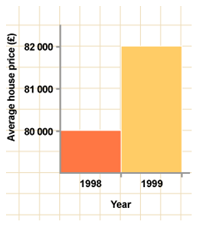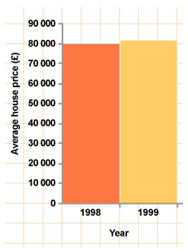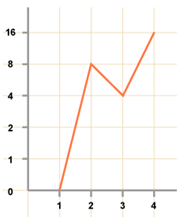Displaying Data
| Site: | Clare-Gladwin RESD |
| Course: | Michigan Algebra I |
| Book: | Displaying Data |
| Printed by: | Guest user |
| Date: | Wednesday, December 24, 2025, 8:02 AM |
Description
Displaying Data
Introduction
We are surrounded by data. It is on the Internet, on television, in newspapers and magazines, in sports, and even on commercials. It is displayed in multiple ways: tables, graphs and charts of all kinds, given in percentages and rankings. Data is truly everywhere we look, which is one of the reasons why we need to be able to read and interpret the data we are surrounded by. Many students may never need to solve long, complicated equations once they leave school, but interpreting and understanding data is a skill you will use your entire life.Types of Displays
By now you probably have been exposed to many types of displays: pie charts, line graphs, bar graphs, maybe even stem and leaf plots and histograms. There are multiple ways to display data. The display used depends on the type and number of data to be displayed.Basics of Graphing
Once you have organized the data in a table, you will want to graph the data. Graphing gives a picture of the data that often cannot be seen just from a table. Look for relationships between the variables and general trends: is the data increasing or decreasing.For a refresher on the basics of graphing on a coordinate plane, select the following link:
Graphing on Coordinate Plane
Video Lesson
For a video lesson and review of tables and line plots select the following link:
For a video lesson and review of stem-and-leaf plots select the following link:
Guided Practice
To solidify your understanding of displaying data and choosing the best display, visit the following links to Holt, Rinehart and Winston Homework Help Online. It provides examples, video tutorials and interactive practice with answers available. The Practice and Problem Solving section has two parts. The first part offers practice with a complete video explanation for the type of problem with just a click of the video icon. The second part offers practice with the solution for each problem only a click of the light bulb away.Guided Practice #1
Guided Practice #2
Misleading Graphs
The most important thing to do when given a graph of data is to interpret the data. Sometimes graphs are made in an attempt to mislead the reader. They are often used to prove a point, and can easily be twisted in favor of that point. These misleading graphs are often used in the media to help a certain group to win over people for their cause.The following is a list of ways to make a graph misleading:
- The scale is too narrow or there is not a big enough range. Data looks like it has a big difference when really it does not.
- There is no scale at all.
- The bars are not equal widths.
- The intervals on the graph are not equal, but are depicted as equal.
- There is missing information.
Example 1
Why is the graph below misleading? How should it be represented? 
Step 1. Look at the graph critically for misleading information in the scale, increments, or labels.
From this graph, it looks as though house prices have tripled in one year! It is misleading because the vertical axis does not start at 0.
Step 2. Make a new graph by changing the misleading part of the original.
In this case it is important to fix the scale of the vertical axis.

Example 2
What makes this graph misleading? 
Step 1. Look at the graph critically for misleading information in the scale, increments, or labels.
Although the vertical scale starts at 0, it does not go up in even steps. This distorts the graph, and makes it look as though the biggest jump is between 1 and 2, rather than 3 and 4.
Also, there are no labels on the axes, so we have no idea what this graph represents!
Video Lesson
For a video lesson on recognizing misleading graphs, select the following link:Misleading Graphs Video
Guided Practice
To solidify your understanding of recognizing misleading graphs, visit the following link to Holt, Rinehart and Winston Homework Help Online. It provides examples, video tutorials and interactive practice with answers available. The Practice and Problem Solving section has two parts. The first part offers practice with a complete video explanation for the type of problem with just a click of the video icon. The second part offers practice with the solution for each problem only a click of the light bulb away.Guided Practice
Interactive Quiz
For an interactive quiz on interpreting data, select the following link:Interpreting Data Quiz
For an interactive quiz on misleading graphs, select the following link:
Misleading Graphs Quiz
Practice
Displaying Data WorksheetAnswer Key
Displaying Data Answer KeySources
GSCE Bitesize, http://www.bbc.co.uk/schools/ gcsebitesize/maths/data/representingdata2rev5.shtml (accessed 08/30/2010).
Glencoe, "Self Check Quizzes." http://www.glencoe.com/sec/math /studytools/cgi-bin/msgQuiz.php4?isbn=0-07-829631-5&chapter=2&lesson=4&headerFile=4&state=na (accessed 08/24/2010).
Holt, Rinehart, and Winston, http://go.hrw.com/math/midma/ gradecontent/loadlesson.html?course=c3&chapter=4&lesson=5&SE=1&sz_audio=1&calc=1&state=xx&actCourse=4 (accessed 08/24/2010).
Holt, Rinehart, and Winston, http://my.hrw.com/math06_07/ nsmedia/lesson_videos/msm3/player.html?contentSrc=6268/6268.xml (accessed 08/24/2010).
Holt, Rinehart, and Winston, "Recognizing Misleading Graphs." http://my.hrw.com/math06_07/nsmedia/homework_help/alg1/alg1_ch10_04_homeworkhelp.html (accessed 08/24/2010).
Holt, Rinehart, and Winston, "Quiz." http://go.hrw.com/math/midma/ gradecontent/loadlesson.html?course=c3&chapter=4&lesson=6&SE=1&sz_audio=1&calc=1&state=xx&actCourse=4 (accessed 08/24/2010).
Holt, Rinehart, and Winston, "Which Display is Best?." http://my.hrw.com/math06_07/nsmedia/homework_help/msm3/msm3_ch09_08_homeworkhelp.html (accessed 08/24/2010).
Math Forum, "An Introduction to the Coordinate Plane." http://mathforum.org/cgraph/cplane/ (accessed 08/24/2010).